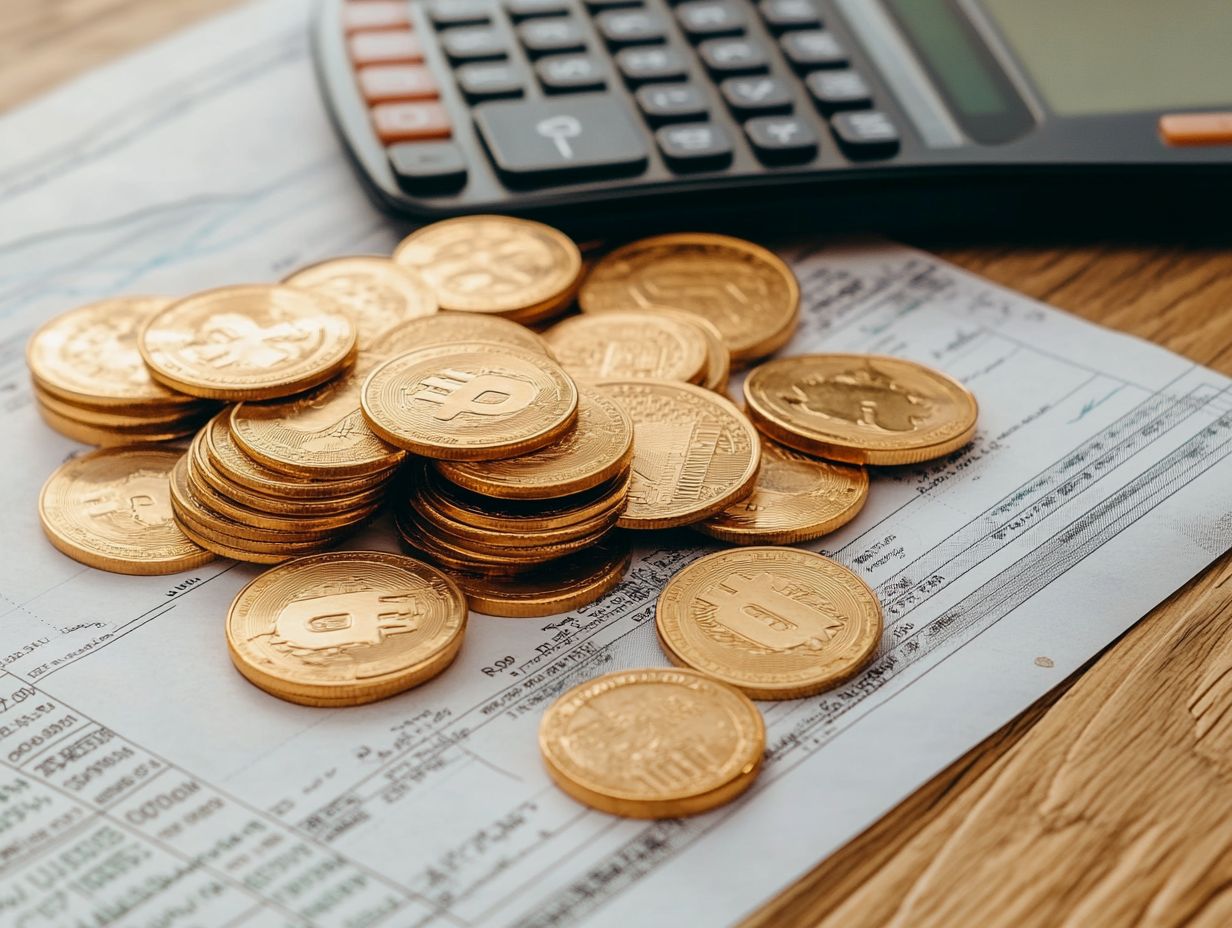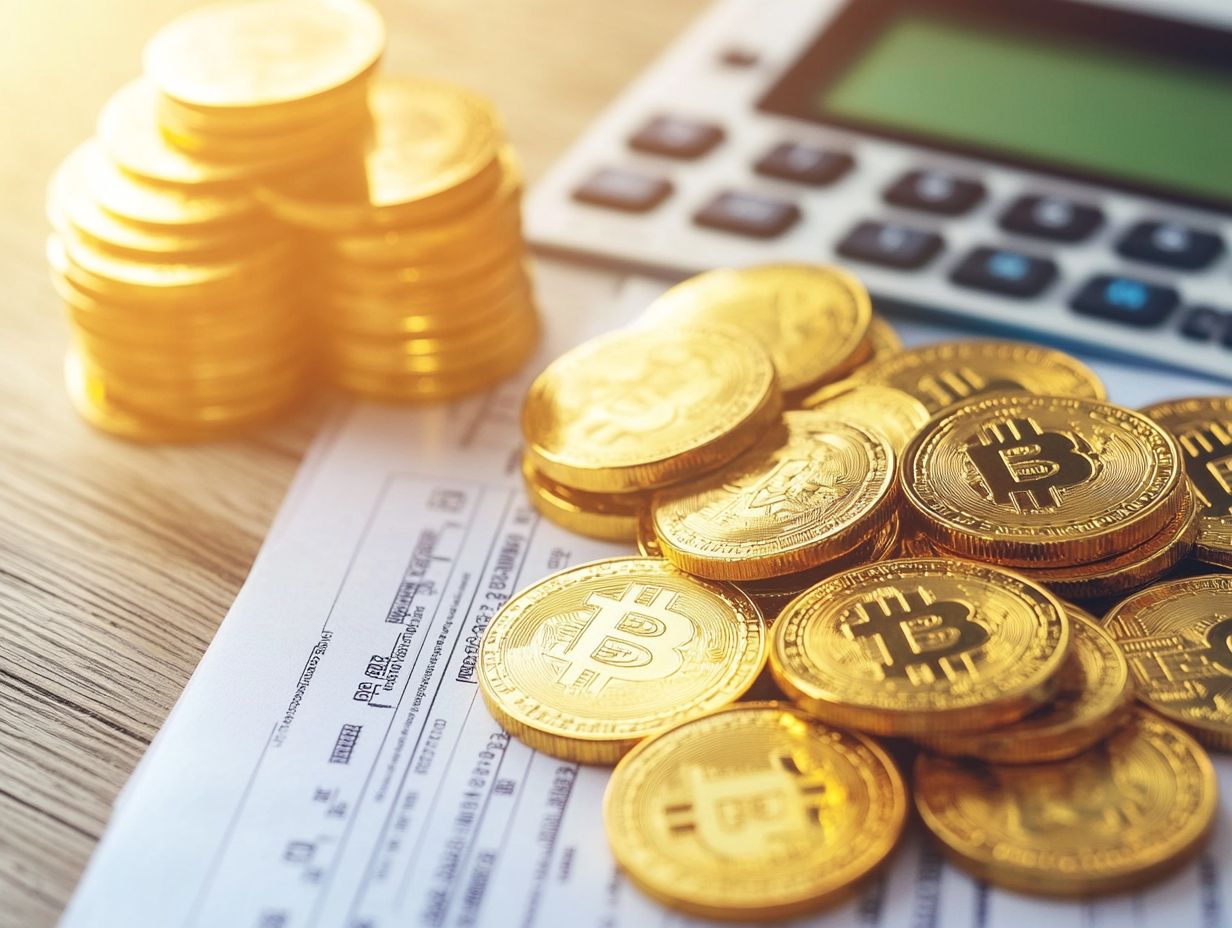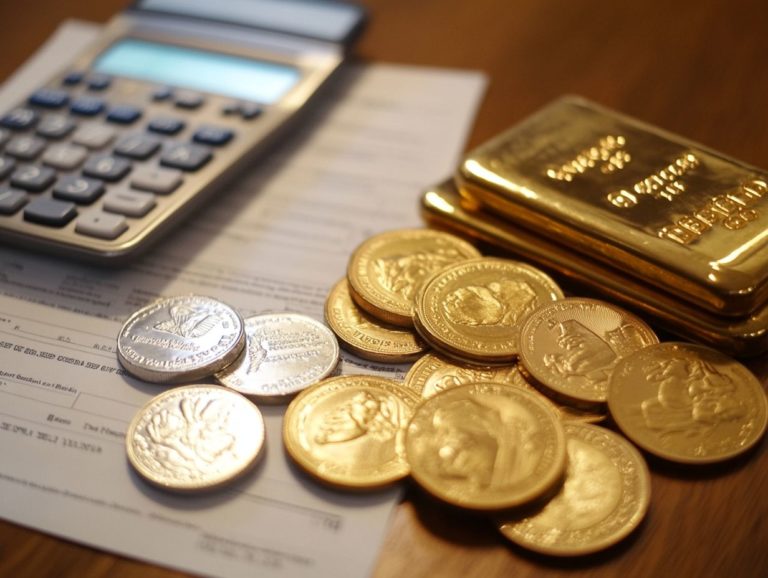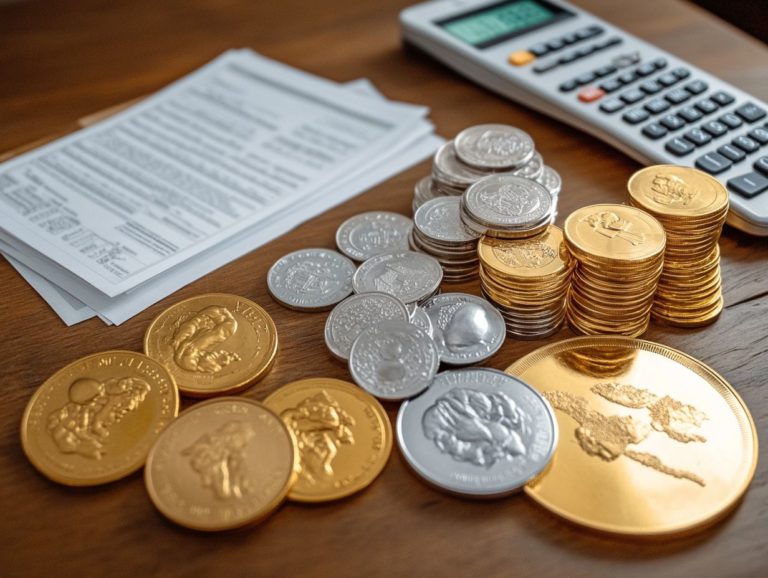How to Handle Tax Liabilities on Precious Metals Sales
Navigating the world of precious metals sales can be both lucrative and intricate. Understanding your tax liabilities is crucial for investors aiming to maximize returns and minimize costs.
With numerous laws and regulations governing gold, silver, platinum, and other metals, grasping how these factors impact your tax responsibilities becomes essential. This guide delves into the nuances of calculating tax liabilities, explores tax-efficient investment strategies, and ensures compliance with reporting requirements.
It also highlights common pitfalls to avoid, empowering you to make informed decisions that could ultimately save you money!
Contents
- Key Takeaways:
- Understanding Tax Liabilities on Precious Metals Sales
- Types of Precious Metals and Their Tax Implications
- Calculating Tax Liabilities
- Strategies for Minimizing Tax Liabilities
- Reporting Precious Metals Sales on Tax Returns
- Common Mistakes to Avoid
- Frequently Asked Questions
- What are tax liabilities on precious metals sales?
- How are tax liabilities on precious metals sales calculated?
- Do I have to pay taxes on all precious metals sales?
- What is the tax rate for precious metals sales?
- Is there a deadline for paying taxes on precious metals sales?
- How can I minimize my tax liabilities on precious metals sales?
Key Takeaways:

- Become familiar with tax laws and regulations to understand your tax liabilities on precious metals sales.
- Different types of precious metals have varying tax implications. Knowing the specific rules for each metal is important.
- Consider tax-efficient investment options.
- Report precious metals sales properly to minimize tax liabilities and avoid penalties.
Understanding Tax Liabilities on Precious Metals Sales
Understanding tax liabilities on precious metals sales is essential. It helps maximize returns and reduce tax implications. In the United States, selling precious metals like gold and silver can trigger several tax obligations, including taxes on the profit from selling your assets from the IRS.
These taxes can fluctuate based on factors such as how long you’ve held the investment, the type of precious metal sold, and the specific tax regulations in your state.
Sprott s Physical Bullion Trusts offer you a strategic pathway to navigate these complexities. They help you optimize your holdings and meet your reporting obligations with confidence.
Overview of Tax Laws and Regulations
An overview of tax laws and regulations unveils the intricate framework governing the taxation of investments in precious metals. You need to be aware of the IRS’s guidelines regarding capital gains and collectibles tax rates, as these can significantly impact your returns.
Understanding these rates is paramount. They can range from 15% to as high as 28%, depending on your income level and how long you hold the metals. Precious metals like gold and silver fall into the collectible category, incurring a steeper tax rate of 28%. This poses challenges for anyone aiming to maximize their investment strategies, making it crucial to consider navigating complex tax issues in precious metals investments.
It’s also vital to consider how these taxes interact with your ordinary income. This can shape your overall financial landscape. Additionally, understanding the relationship between precious metals and capital gains tax is important. Ensuring compliance with these regulations is crucial; ignoring IRS guidelines could lead to penalties and unexpected tax liabilities.
Types of Precious Metals and Their Tax Implications
Exploring the world of precious metals unveils unique tax implications that are essential for you to consider. Investments in gold, silver, platinum, and palladium are subject to different treatment under IRS regulations, which can significantly influence your investment strategies and the management of your capital assets.
Understanding these nuances enables you to make informed decisions that align with your financial goals.
Gold, Silver, Platinum, and Other Metals
Gold, silver, platinum, and palladium each come with their own set of tax implications that you need to consider. This is especially true regarding how the IRS classifies them as collectibles or capital assets.
If these metals are labeled as collectibles, any gains from their sale could lead to a steeper capital gains tax rate of 28%. Conversely, if they’re classified as capital assets, you might enjoy a more attractive tax rate of 15% or 20%, depending on your income bracket. To learn more about optimizing your investments, check out our guide on how to minimize tax liabilities on precious metals.
Knowing these differences is key when planning your investment strategies. Factors like holding periods, storage costs, and market fluctuations play significant roles in effectively managing these assets. You can optimize your returns by timing your sale or using retirement accounts with tax advantages.
Calculating Tax Liabilities

Calculating tax liabilities on the sale of precious metals requires you to assess their market value carefully and grasp the important distinctions between short-term gains and long-term gains. These factors are essential for ensuring accurate reporting and effective tax planning.
Factors Affecting Tax Amount
Several factors can significantly influence the tax amount on your precious metals sales. These include the type of metal you re dealing with, the length of time you ve held it, and specific state regulations regarding sales tax and capital gains tax.
One crucial aspect to consider is your investment duration. Typically, if you hold your assets for over a year, you may qualify for more favorable long-term capital gains rates. In contrast, selling after a shorter period could lead to higher short-term rates that can reduce your profits.
Different metals like gold, silver, or platinum can also face varying tax treatments. Some state laws impose additional taxes based on the sale price or type of transaction. Therefore, understanding these variables is essential, as they not only shape your potential returns but also influence how you strategize your purchases and sales to effectively minimize your tax liabilities. For more insights, explore the future of taxation in precious metals investment.
Strategies for Minimizing Tax Liabilities
Want to boost your investment returns? You can significantly enhance your overall investment returns by implementing effective strategies for minimizing tax liabilities on your precious metals investments. Consider options like utilizing a 1031 exchange a tax deferral strategy for real estate that might apply to precious metals or consulting a financial advisor who can customize the approach to fit your unique circumstances.
Tax-Efficient Investment Options
Investors like you, seeking tax-efficient options in precious metals, can explore a variety of strategies. These include selecting the right types of investments and carefully timing your sales to optimize capital gains taxation.
Financial advisors often suggest considering long-term holding strategies, such as acquiring bullion or coins that qualify for favorable tax treatment. By holding these assets for over a year, you can take advantage of lower long-term capital gains tax rates. Additionally, understanding the basics of tax loss harvesting in precious metals can significantly enhance your overall returns.
Structuring your investments through a self-directed IRA offers another path to tax efficiency. This allows for tax-deferred growth, enabling you to expand your precious metals portfolio while minimizing immediate tax liabilities. Understanding the tax regulations for precious metals in retirement accounts can support a more robust and effective financial plan.
Reporting Precious Metals Sales on Tax Returns
When it comes to reporting precious metals sales on your tax returns, careful attention to detail is essential. You need to accurately complete various forms and documentation to comply with IRS regulations and avoid any potential penalties.
Every piece of information matters, ensuring that your investment activities align with the requirements set forth by the tax authorities.
Forms and Documentation Required

The forms and documentation you need for reporting precious metals sales include specific IRS forms that must be completed with precision to meet your reporting obligations and avoid penalties.
In many instances, these forms involve Schedule D and Form 8949. These forms are essential for tracking gains and losses from asset sales, including your precious metals. Understanding the tax benefits of holding precious metals in a trust can also be beneficial. You’ll need to adhere to strict deadlines for filing, typically aligning with the April tax deadline, and be prepared to provide additional documentation, such as receipts or invoices, to substantiate your transactions.
Maintaining meticulous records is crucial; it not only supports the claims you make on your tax returns but also equips you for any potential audits from the IRS. Understanding the tax implications of precious metals in different states can be key to validating the nature and value of your sales, ensuring a smoother tax experience.
Common Mistakes to Avoid
Identifying the common mistakes to avoid regarding the tax implications of precious metals sales is essential for you as an investor. This awareness will help you prevent costly penalties and ensure full compliance with IRS regulations.
Stay informed and proactive to maximize your gains!
Potential Penalties for Non-Compliance
Potential penalties for failing to comply with IRS regulations regarding precious metals sales can be quite severe. This can significantly affect your overall financial standing and investment returns.
Not adhering to these regulations can result in substantial fines and legal consequences. There is also a risk of audits that may uncover additional financial discrepancies. You must understand the importance of meeting your tax obligations to avoid such penalties, as the ramifications of non-compliance can be deeply damaging.
To protect your interests, ensure that you’re accurately reporting your transactions and maintaining meticulous records. Stay updated on the ever-evolving tax laws. By adopting careful practices and seeking guidance from tax professionals, you can effectively minimize your risks and safeguard your financial interests in the precious metals market. Consider exploring tax strategies for precious metals to enhance your investment portfolio.
Frequently Asked Questions
What are tax liabilities on precious metals sales?
Tax liabilities on precious metals sales refer to the taxes that must be paid on any profit made from the sale of precious metals such as gold, silver, or platinum.
How are tax liabilities on precious metals sales calculated?

Tax liabilities on precious metals sales are typically calculated by subtracting the purchase price of the metal from the selling price. Then, apply the appropriate tax rate to the resulting profit.
Do I have to pay taxes on all precious metals sales?
It depends. In general, any profit made from the sale of precious metals is subject to taxes. However, there are certain exceptions and exemptions that may apply, such as if the precious metal was used for personal use rather than investment purposes.
What is the tax rate for precious metals sales?
The tax rate for precious metals sales varies depending on several factors, including the type of metal, the length of time the metal was held, and the individual’s tax bracket. It is best to consult a tax professional for specific information on tax rates.
Is there a deadline for paying taxes on precious metals sales?
In most cases, taxes on precious metals sales are due by the tax filing deadline for the year in which the sale was made. Some exceptions may apply for certain types of sales, so it is important to consult a tax professional for specific information.
How can I minimize my tax liabilities on precious metals sales?
There are several strategies that can help minimize tax liabilities on precious metals sales. These include holding the metal for a longer period of time, utilizing tax loss harvesting, and taking advantage of tax deductions and exemptions. It is best to consult a tax professional for personalized advice on minimizing tax liabilities.
Understanding your tax obligations related to precious metals is crucial for protecting your investments. Don t hesitate to consult a tax professional for guidance tailored to your situation.














